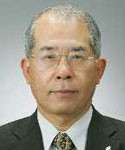Keynote Addresses
Keynote I : Wednesday, January 25, 9:00-10:00, Small Auditorium, 5F
Automotive Electronics: Steady Growth for Years to Come

Alberto Sangiovanni-Vincentelli
The Edgar L. and Harold H. Buttner Chair of Electrical Engineering and
Computer Science, University of California, Berkeley
and Chief Technology Advisor, Member of the Board and Co-founder, Cadence
Design Systems United States
The world of electronics is witnessing a revolution in the way products are conceived, designed and implemented. The ever growing importance of the web, the advent of microprocessors of great computational power, the explosion of wireless communication, the development of new generations of integrated sensors and actuators are changing the world in which we live and work. The new key words are:
- Disappearing electronics, i.e., electronics has to be invisible to the user, it has to help unobtrusively.
- Pervasive computing, i.e., electronics is everywhere, all common use objects will have an electronic dimension.
- Ambient intelligence, i.e., the environment will react to us with the use of electronic components. They will recognize who we are and what we like.
- Wearable computing, i.e., the new devices will be worn as a watch or a hat. They will become part of our clothes. Some of these devices will be tags that will contain all important information about us.
- Know more, carry less, i.e., the environment will know more about us so that we will not need to carry all the paraphernalia of keys, credit cards, personal I.D.s, access cards, access codes.
The car as a self-contained microcosm is experiencing a similar revolution: all the key words listed above are going to have a great impact on the automotive world. We need to rethink what a car really is and the role of electronics in it. Electronics is now essential to control the movements of a car, of the chemical and electrical processes taking place in it, to entertain the passengers, to establish connectivity with the rest of the world, to ensure safety. What will an automobile manufacturer's core competence become in the next few years? Will electronics be the essential element in car manufacturing and design? The challenges and opportunities are related to
- how to integrate the mechanical and the electronics worlds, i.e., how to make mechatronics a reality in the automotive world,
- how to integrate the different motion control and power-train control functions so that important synergies can be exploited,
- how to combine entertainment, communication and navigation subsystems,
- how to couple the world of electronics where the life time of a product is around 2 years and shrinking, with the automotive world, where the product life time is 10 years and possibly growing,
- how to develop new services based on electronics technology,
- how to exploit communication among cars and between cars and infrastructure such as Global Positioning Systems and cellular networks,
- how are the markets evolving (for example, what will be the size of the after-market sales for automotive electronics, if any?).
We will pose these questions while reviewing some of the most important technology and product developments of the past few years. We will also present new trends on how the design of electronics of the car should be carried out. We will finally analyze the dynamics of the automotive electronics industry that is bound to produce a major shake-up in the structure of the design chain with particular emphasis on the AUTOSAR consortium.
Keynote II : Thursday, January 26, 9:00-10:00, Small Auditorium, 5F
Challenging Device Innovation

Satoru Ito
President & CEO RENESAS Technology Corp. Japan
The semiconductor industry has continuously transformed our way of life, through a number of underlying technology breakthroughs and innovations over the past years. There are currently two challenges that this industry faces: a limitation of miniaturization technology and a difficulty in maintaining an economy of scale. To cope with these challenges, there is a growing need to work closely with partners and customers who have business related to semiconductors, in addition to semiconductor manufacturers. Especially in the area of semiconductor design, we see a need to create a new EDA methodology that broadens the definition of traditional EDA and re-defines the connection among system designers, SoC designers and development tool designers. As we move closer to the realm driven by the convergence of applications and advancements in miniaturization technology, I'd like to discuss the associated technological challenges as well as economical challenges, and present to you our strategy to overcome these issues.
Keynote III : Friday, January 27, 9:00-10:00, Small Auditorium, 5F
Platform Structure for Digital Products Development (title changed)

Yukichi Niwa
Senior Advisory Director, Group Executive of Platform Technology Development Headquarters CANON INC. Japan
Platform-based development (PBD) aims to continuously add new value in both cases of incremental development and product planning based development. By adding new technology to previously existing technology and by storing the technologies as reusable assets, PBD enables high quality, low cost, and short turnaround time development. Furthermore, PBD allows target-oriented development where we can select and concentrate technology to eliminate unnecessary development.
In order to execute effective PBD, it is important to introduce the firm layer structuring of digital/analog technology so that individual professionals in independent layer can maximize their efficiency without any restraint. The act of layer structuring is nothing but the architectural design of the development methodology. Thus, it's no exaggeration to say that success in business profitability management directly depends on the presence of the good architect.
The important thing in the next stage is to optimize the design process by investing in computer resources. For example, it is necessary to thoroughly adapt simulation technology to the development of high quality imaging technology, embedded system (hardware/software) technology, or communication technology. The quantitative evaluation from the early design phase and the workflow based on the accumulated design know-how (IP, methodology) will accelerate technology innovation and strengthen the platform even further. Eventually, management can directly obtain absolute advantage of large-scale system design effectiveness.
